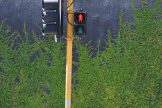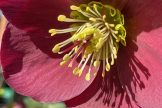
 Important note about plant availability. Important note about plant availability.There are hundreds of factsheets on our website provided for your information. Not all plants will be available at all times throughout the year. To confirm availability please call (03) 8850 3030 and ask for the nursery. |
What defines a climber?
The word climber is used rather loosely when describing plants. Many plants that fall into this category do not strictly climb, but would be more correctly designated ramblers or trailers. A true climber ascends using a variety of clinging methods. Some have aerial roots, which attach themselves to a support, like Ficus pumila. These are also known as self-clinging climbers. Some climb using tendrils, these are tightly curled and once wrapped around something are impossible to pull away without breaking. Eg. Passionfruit. The majority simply ascend by means of the soft young shoots which twine around their host. Eg. Climbing beans. These are also known as twining plants or sub climbers.
There are also plants classed as climbers which are actually ramblers. Eg. Wisteria sp. These plants naturally spread their branches along the ground, but readily take advantage of any shrub or tree in their path over which they can ascend. They can be held and trained to grow along pergolas etc.
Environmental benefits
Shading and insulation for walls can be provided by plants that adhere to the wall. This is an excellent, low cost way to cut down your heating and cooling costs. Plants such as boston ivy will give results very quickly and will have the added advantage of allowing warmth through in winter when the leaves have fallen off. Most importantly they will not damage brickwork that is in good condition. Virginia creeper will also help to keep moisture out of the walls.
Another way of reducing your carbon footprint is by reducing your energy use using vertical shading. This is best for east and west facing walls and windows. An evergreen vine can be grown up the wall or, in the case of windows, a trellis or similar. This will provide year round insulation. Horizontal shading is best for north-facing windows, e.g. Deciduous vines such as ornamental grape or wisteria grown over a pergola.

Aesthetic benefits
Climbing plants are an important part of any well-designed garden. They can cloak unsightly garden boundaries and cover arbors to divide your space. They add height to the garden by covering tripods and obelisks, and grow through trees and shrubs or through hedges. They will often continue flowering when their host has finished blooming.
You can allow climbers to cascade from window boxes for that exotic effect. (Geraniums and Bouganvilleas perform best). Retaining walls can also be given a softer and more colourful side by planting multiples of the same species and allowing them to cascade down.
Some ideas to suit your needs:
Compact Climbers
The following would be suitable for growing in a small to medium sized area.
– Thunbergia alata, Black-eyed susan, 2m
– Clematis aristata, Old man’s beard, 2-4m
– Mandevilla, syn. Dipladenia, 2m
– Trachelospermum asiaticum, 4m
– Clematis hybrids, 2-3m
– Mandevilla laxa, 2-3m
– Hoya spp., 2m
Self-clinging Climbers
The beauty of these is no support is needed. They’ll soften a hard or glaring wall and keep what’s on the other side cool.
– Ficus pumila, Climbing Fig, indefinite (Pic at top of page and below)
– Parthenocissus tricuspidata, Boston Ivy, indefinite
– Parthenocissus quinqefolia, Virginia Creeper, indefinite
– Hydrangea petiolaris, Climbing Hydrangea, indefinite


Productive Climbers
A vine that looks decorative and supplies you with fruit
– Actinidia chinensis, chinese gooseberry, kiwi fruit, 3-5m
– Passiflora edulis, passionfruit, 3m
– Billardiera scandens, apple berry, 2-4m
– Vitis sp, grapevines, indefinite

Deciduous with good autumn foliage
– Parthenocissus tricuspidata*, boston ivy, indefinite
– Parthenocissus quinqefolia*, virginia creeper, indefinite
–Vitis coignetiae, the Glory Vine with big, rounder leaves than the standard Glory Vine. Very beautiful red leaf colour in autumn.
–Vitis vinifera, the non fruiting grape vine – commonly called a Glory Vine.
House Swallowers
These should be planted with caution, as they never say die or stop climbing. They are fast, vigorous and attach themselves securely.
– Bouganvillea trailii, bouganvillea, indefinite
– Pandorea pandorana, Wonga-wonga vine, indefinite
– Wisteria sinensis, Wisteria, indefinite
– Solanum jasminoides, Potato vine, indefinite
Spring Flowering
The following will promise you that spring has arrived. Some will even provide a perfume.
– Clematis montana ‘alba’, 6m
– Clematis microphylla Old Man’s Beard, 6m (Indigenous to Melbourne)
– Jasminum mesnyi, 3m
– Jasminum polyanthum, 6m
– Trachelospermum jasminoides, 4-6m

Drought Tolerant
Hardy plants that will tolerate dry periods once established.
– Bouganvillea sp. ‘Mrs Butt’, 3-4m
– Clematis microphylla Old Man’s Beard, 6m (Indigenous to Melbourne)
– Hardenbergia violacea Purple Coral Pea / Happy Wanderer 3m
– Kennedia rubicunda, dusky coral pea, 5m
– Lonicera heckrottii ‘firecracker’, 5m
Climbers for pots
These perform excellent in a pot, they enjoy the warmth and don’t mind conditions a little on the dry side.
– Bouganvillea sp. Bambino Bougs, 1.5m
– Pelargonium spp. Climbing geraniums, 2m trailing
– Mandevilla, syn. Dipladenia, 2m
– Mandevilla x, ‘alice du pont’, 4m
Cascading climbers
Makeover an old an tired embankment with one of these native beauties.
– Clematis microphylla Old Man’s Beard, 6m (Indigenous to Melbourne)
– Hibbertia scandens, snake vine, 2-5m
– Hardenbergia sp., 3m
– Kennedia eximia, 2m
– Metrosideros carminea, climbing rata vine, 2m
Climbers for shady spots
Give some life to that dark, narrow side way. They won’t need a lot of root space, and some will even attach straight on the fence/wall*.
– Aphanopetalum resinosum, sun vine, 2m
– Trachelospermum jasminoides, star jasmine, 4m
– Hibbertia scandens, snake vine, 2-5m
– Ficus pumila*, climbing fig, indefinite
– Parthenocissus tricuspidata*, boston ivy, indefinite
– Parthenocissus quinqefolia*, virginia creeper, indefinite
– Hydrangea petiolaris*, climbing hydrangea, indefinite
– Hardenbergia violace, native wisteria, 3m

Best climbing roses
Baag’s favourite climbing roses for arbors and pergolas.
– ‘Gold Bunny’ (yellow)
– ‘Altissimo’, ‘Dublin Bay’, ‘Black Boy’(red)
– ‘Lamarque’ (white)
– ‘Twilight Glow’, ‘Crepescule’ (apricot)
– ‘Lorraine Lee’, ‘Zepharine Druin’ (pink)
Ramblers for hedging
If you want to create a dense, informal screen, these ramblers will do just that.
– Muehlenbeckia complexa, maidenhair, 3m
– Tecomaria capensis, cape honeysuckle, 3-4m
– Solanum rantonnetii ‘royal robe’, 2m
Weedy climbers to avoid
The following have shown to be invasive in the local area so we do not stock them.
– Gelsimium sempervirens, Carolina Jasmine
– Ipomoea sp, Morning Glory
– Sollya heterophylla, Bluebell Creeper
– Hedera sp, English Ivy





